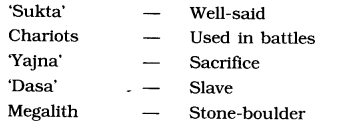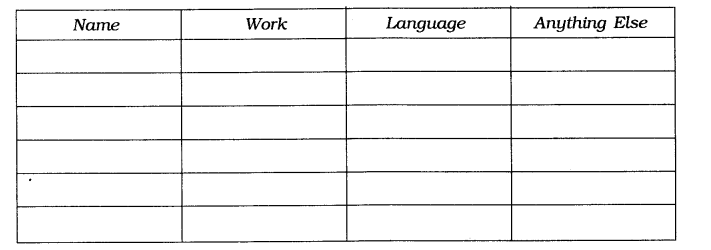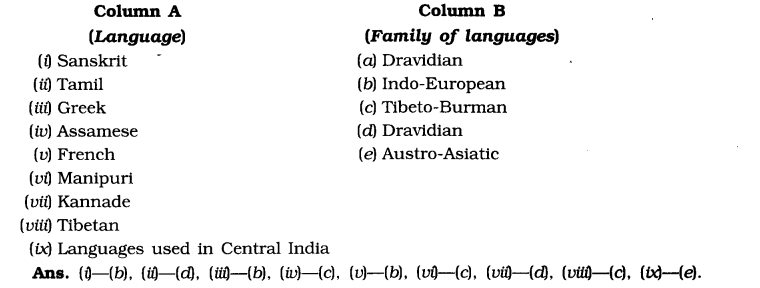What Is The Name Of The 5th Chapter Of The Social Animal
NCERT Solutions for Class 6th Social Science History Chapter 5 What Books and Burials Tell The states
1. Match the columns:

Ans.

2. Megalith Consummate the sentences:
- Slaves were used for…………….
- Megaliths are found in……………
- Stone circles or boulders on the surface were used to………………..
- Port-holes were used for……………
- People at Inamgaon ate…………….
Answer:
- Work
- South Bharat, north-eastward and Kashmir
- indicate the exact identify of burial
- burying the other fellow member of the aforementioned family at the aforementioned place
- wheat, barley, rice, pulses, millets, peas, sesame, etc.
3. In what ways are the books we read today different from the Rigveda?
Ans: The books nosotros read today are written and printed. The Rigveda was recited and heard rather than read. For many years from generation to generation, the process continued. It was written down several centuries afterwards information technology was first composed and printed less than 200 years ago.
4. What kind of evidence from burials do archaeologists apply to observe out whether there were social differences amongst those who were buried?
Ans:
Sometimes, archaeologists notice a circle of stone boulders or a unmarried large stone standing on the basis. These are the simply indications that there are burials beneath.
All these burials have some mutual features. Generally, the dead were cached with distinctive pots, which are chosen Black and Red Ware. Too establish are tools and weapons of fe and sometimes, skeleton of horses, horse equipment and ornaments of stone and gilt.
Several kinds of evidences from burials do archaeologists use to discover out that there were social differences among those who were buried underneath the megaliths. They think that objects found with a skeleton probably belonged to the dead person. Sometimes more than objects were plant in one grave than in another. For instance in Brahmagiri, one skeleton was cached with 33 aureate beads, 2 rock beads, 4 copper bangles and one conch vanquish. Other skeletons had only a few pots. Perhaps there were differences in condition amongst the people who were buried. Perhaps some were rich, others poor, some chiefs, others followers.
five. In what means do you call up that the life of a 'raja' was unlike from that of a 'dasa' or 'dasi'?
Ans:In the society, 'raja' was i of the highest civil positions. 'Rajas' were the kings of the community, whereas the 'dasas'/'dasis' were the everyman position in gild. The 'dasas'/'dasis' were slaves who were used for work. They were treated equally the belongings of their owners. They were captured in war.
vi. Find out whether your school library has a collection of books on organized religion, and list the names of 5 books from this collection.
Ans:Do yourself with the help of your subject area-teacher and school librarian. A sample set up of five such books:
- The Mahabharata
- The Ramayana
- The Bible
- The Bhagwad Gita
- The Quran
seven. Write downward a curt poem or song that you accept memorised. Did you hear or read the verse form or vocal? How did you larn it by centre?
Ans: Do yourself.
8. In the Rigveda, people were described in terms of the work they did and the languages they spoke. In the table below, JiR in the names of six people you know, choosing three men and iii women. For each of them, mention the piece of work they do and the language they speak. Would you lot like to add annihilation else to the description?

Ans. Do yourself.
I. MULTIPLE CHOICE QUESTIONS
Choose the correct choice to complete the statements given beneath:
(i) The Ghoda is a tributary of the …………….
(a) Ganga
(b) Narmada
(c) Krishna
(d) Bhima
(ii) Brahmagiri is a site in modem ……………..
(a) Andhra Pradesh
(b) Kerala
(c) Uttar Pradesh
(d) Bihar.
(iii) Which of these was not a category of people in the society?
(a) Shudra
(b) Brahmin
(c) Raja
(d) Dasa.
(iv) Inamgaon is situated on the river
(a) Ghod
(b) Bhima
(c) Son
(d) Narmada.
(v) The Ghoda is a tributary of the …………………
(a) Ganga
(b) Narmada
(c) Krishna
(d) Bhima.
(vi) Brahmagiri is a site in modem ……………..
(a) Andhra Pradesh
(b) Kerala
(c) Uttar Pradesh
(d) Bihar.
Answer:
(i) – (b), (2) – (a), (three) – (a), (four) – (b), (v) – (d), (half-dozen) – (a).
II. FILL IN THE BLANKS
Fill up in the blanks with appropriate words to complete each sentence:
- The oldest of the Vedas is ………..
- The Rigveda was composed about …….. years ago.
- The hymns in the Vedas have been referred to every bit ………….. which means …………….
- The major gods praised in the hymns of the Rigveda were: ……………………….and …………
- Sanskrit is part of the ………….. family unit of languages.
- In a hymn in the Rigveda, Vishvamitra used the give-and-take 'sisters' for the ii rivers ……and…….
- 'Brahmins' and 'Rajas' were two groups of people in terms of…………………..
- Slaves were captured during………………..
- Stone boulders used for marking burial sites are called …………………
- Blackness and Red Ware are words used for…………….. that were cached with the dead.
Answer:
- the Rigveda
- 3500
- 'Sukta', well-said
- Indra, Agni, Soma
- Indo-European
- Beas, Sutlej
- Piece of work
- war
- megalithsMpots.
III.Truthful/Simulated
State whether these sentences are truthful (T) or false (F).
- The Rigveda was written for the offset time past manus about 3500 years ago.
- Soma was the warrior god.
- The Rigveda contains prayers for cattle, children, and horses.
- Battles were fought for land, water, and to capture people.
- Sons automatically succeeded fathers as 'rajas'.
- Megaliths were used to mark burial sites.
- Members of families were usually buried together.
- In a hymn in the Rigveda, Vishvamitra has a dialogue with Beas and Sutlej, which were 2 women.
- Sanskrit and Tamil belong to the same family of languages.
Answer:
- F
- F
- T
- T
- F
- T
- T
- F
- F
IV. MATCHING SKILL
Friction match the items given in column A correctly with those given in column B

5.VERY Curt ANSWER Blazon QUESTIONS
1. Name the iv Vedas.
Ans: The iv Vedas are:
- Rigveda
- Samaveda
- Yajurveda
- Atharvaveda '
2. In what language has the Rigveda been composed?
Ans: The Rigveda is in Vedic Sanskrit.
3. What were the diverse purposes of fighting battles as depicted by the Rigveda?
Ans: Battles were fought for cattle, land, water, and for capturing people.
4. What were the groups of people in terms of their work?
Ans: There were two groups of people in terms of their work—the 'brahmins' and the 'rajas'.
5. Who were the 'Aryas' and the 'Dasas'? [V. Imp.]
Ans: People who composed the hymns called themselves Aryans and they chosen their opponents 'Dasas'.
6. What were megaliths? [Imp.]
Ans: Stone boulders used to marking burial sites are known as megaliths.
7. Proper name some areas where megaliths were prevalent.
Ans:Megaliths were prevalent in the Deccan, Due south India, in the North-east, and Kashmir.
8. How is it known that burying spots were meant for families?
Ans:Sometimes megaliths contain more than one skeleton. This indicates that families were buried together.
ix. Where is Inamgaon situated?
Ans: Inamgaon is a site on the river Ghod, a tributary of the river Bhima.
Vi.SHORT ANSWER TYPE QUESTIONS
1. Write a brusk note on the Rigveda. [V. Imp.]
Ans: The Rigveda is the oldest of the Vedas. It indicates over a m hymns in Vedic (old) Sanskrit. These hymns (chosen 'Sukta' — well said) are in praise of various gods and goddesses, mainly: Agni, Indra and Soma. These hymns were equanimous by sages, who learned them and made their children larn. Finally, they were printed about 200 years ago.
2. Describe in brief about how the Rigveda depicts cattle, horses, chariots, and battles.
Ans: Rigveda has prayers for cattle and horses. Horses were used in battles. Battles were fought for cattle, land, people and water. Virtually men took office in wars. There was not whatever regular army. There were assemblies where people met and discussed matters of state of war and peace. They chose brave warriors as their leaders.
iii. Write a brusk note on megaliths.
Ans: Megaliths are rock boulders used to mark burial sites. They were prevalent effectually 3000 years agone in the Deccan, South Bharat, in the northeast and in Kashmir. Some megaliths are seen on the surface and some are underground. Sometimes a circle of stone boulders or a unmarried large stone is found continuing on the footing, to indicate the position of burials.
4. How do megaliths evidence that at that place were social differences? [V. Imp.]
Ans: Sometimes, more objects are in found in ane grave than in another. This indicates that people were buried co-ordinate to their social status. In Brahmagiri, a skeleton was establish with 33 aureate beads, 2 stone chaplet, 4 copper bangles, and a conch shell. Whereas other skeletons have simply few pots.
7.LONG Reply Type QUESTIONS
1. How have people in lodge been depicted in the Rigveda? [V. Imp.]
Ans: Co-ordinate to the Rigveda, there are two groups of people in terms of their work: (i) The priests, called Brahmins, and (ii) The 'rajas'.
The priests performed diverse vituals while the 'rajas' ruled. These rajas' did not, however, take capital cities, palaces or armies, nor did they collect taxes. Two words were used to refer to the people of the community equally a whole — those wo^ds were 'jana' and Vish'.
The people who composed the hymns referred to themselves using the discussion 'Aryas' and called their opponents 'Dasas' or 'Dasyus', The 'dasas' were afterward slaves and were treated as the holding of their owners.
NCERT SolutionsMathsScienceSocialEnglishHindiSanskritRD Sharma
Source: https://www.learncbse.in/ncert-solutions-for-class-6th-social-science-history-chapter-5-what-books-and-burials-tell-us/
Posted by: powellhinion.blogspot.com

0 Response to "What Is The Name Of The 5th Chapter Of The Social Animal"
Post a Comment